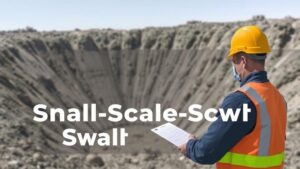Identifying Pay Layers in Glacial Till for Gold Prospecting
Identifying Pay Layers in Glacial Till for Gold Prospecting
Gold prospecting is a captivating pursuit that marries geology with adventure. As prospectors search for the precious metal, understanding glacial till–an accumulation of materials deposited by glacier activity–is vital for effectively identifying potential pay layers. This article will explore what glacial till is, how it relates to gold deposition, and methods for identifying pay layers that may yield gold deposits.
Understanding Glacial Till
Glacial till is a mixture of soil, rock, and sediment that has been transported and deposited by moving glaciers. It often contains a variety of materials, including silt, clay, sand, and larger boulders. This heterogeneous composition can make it challenging for gold prospectors to pinpoint areas rich in gold, particularly when considering that glacial activity can cover up to 20% of the Earths surface.
During the last Ice Age, glaciers advanced and retreated, transporting mineral resources–including gold–from one location to another. As a result, the primary challenge for gold prospectors lies in differentiating between the rich pay layers that contain gold and the barren material that does not.
The Formation of Pay Layers
Pay layers refer to those specific strata within glacial till where economically recoverable amounts of gold have been deposited. Gold tends to accumulate in certain conditions due to factors such as erosion, water transport, and the natural sorting of materials. Understanding these processes is crucial for locating pay layers.
Several geological factors contribute to gold deposition in glacial till:
- Particle Size and Density: Gold is a heavy metal with a high density (approximately 19.3 grams per cubic centimeter). As glaciers move, they carry away lighter materials, allowing gold particles to settle in pay layers.
- Topographic Features: Natural depressions, such as riverbeds and valleys, can collect and concentrate gold as it is washed downstream.
- Mineral Weathering: The weathering of bedrock can release gold particles, which become entrained in the till and subsequently deposited in pay layers.
Techniques for Identifying Pay Layers
Identifying pay layers in glacial till requires a strategic approach. Here are several effective techniques used by gold prospectors:
- Soil Sampling: Collecting soil samples from various depths within the till can help identify the presence of gold. Typically, samples should be taken from both the surface and deeper layers to understand how gold is distributed.
- Metal Detection: Using metal detectors can assist in locating gold nuggets or flakes among the till. This technique is particularly useful in areas known for glacial activity.
- Mapping Glacial Features: Understanding the path of ancient glaciers can provide insight into where gold might accumulate. Historic maps and geological surveys can help identify areas with concentrated glacial till deposits.
Case Studies and Examples
Several regions across North America have yielded significant gold finds in glacial till. For example, areas in Alaska and Canada, particularly around the Klondike River, have a rich history of gold prospecting. The unique glacially deposited landscapes have led to numerous discoveries, with some prospectors reporting finds of over 20 grams of gold per cubic yard of till.
Another notable area is the Witwatersrand Basin in South Africa, where eroded gold-bearing quartzite and conglomerate layers have been surfacing due to glacial activity, leading to extensive mining operations that have produced over 40% of the world’s gold supply.
Challenges and Considerations
While identifying pay layers in glacial till can be rewarding, several challenges exist. Factors such as climate, land access, and environmental regulations must be taken into consideration. Plus, the variability in till deposits means that extensive testing and exploration are often necessary to ensure economic viability.
Also, the prospectors understanding of local geology plays a critical role. Before venturing into unknown areas, obtaining geological maps and data is indispensable.
Actionable Takeaways
- Familiarize yourself with the characteristics of glacial till, focusing on how it affects gold deposition.
- Employ soil sampling and metal detection methods to accurately identify potential pay layers.
- Research historical gold deposits in glacial regions to better understand where to prospect.
- Stay informed about environmental regulations and land access issues to ensure responsible prospecting.
Identifying pay layers in glacial till is a multifaceted process that requires a blend of geological knowledge and practical skills. With the right techniques and tools, prospectors can increase their chances of uncovering valuable gold deposits hidden within this ancient and fascinating landscape.

